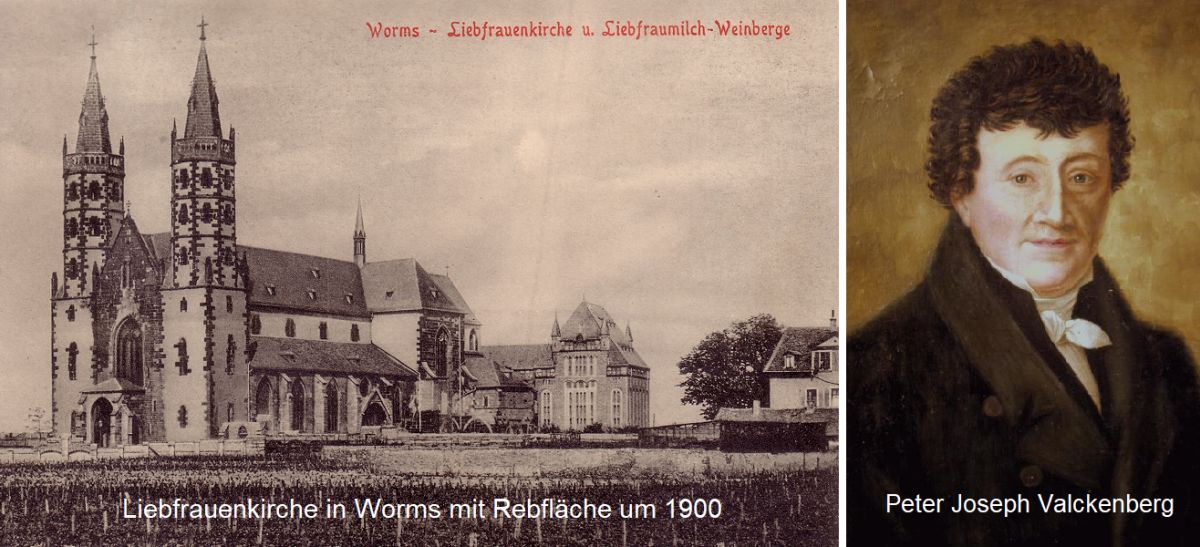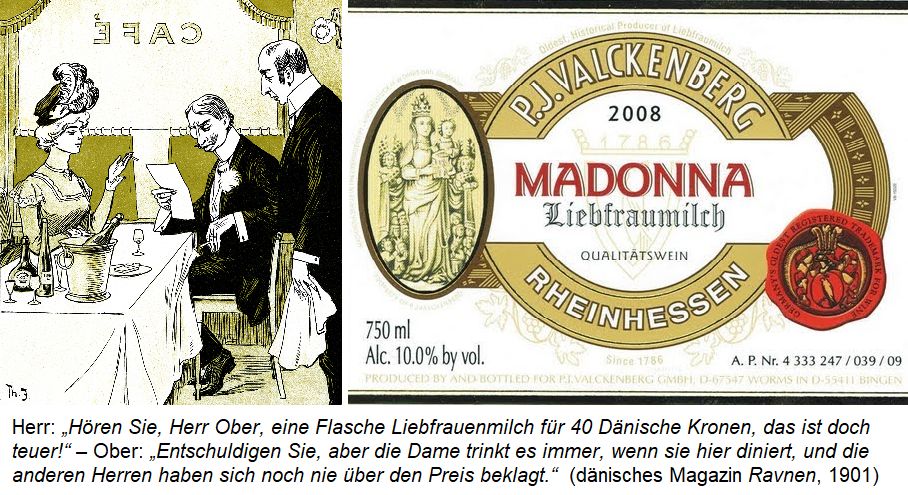Historic branded wine from Germany. The "famous Lieben Frauen Milch zu Worms" was first mentioned in 1744. At that time, this designation could only be used if the grapes grew in the area "as far as the tower of the Liebfrauenkirche cast its shadow". This meant the vineyards of the Capuchin monastery "Stiftskirche Liebfrauenkirche" in Worms in Rheinhessen. Unfortunately, however, this geographically narrowly defined term was later extended to all Rhine wines, thus diluting the origin. In 1808, in the course of the Napoleonic secularisation, the remaining part of the monastery and most of the original vineyards were acquired by the mayor of Worms, Peter Joseph Valckenberg (1764-1837). By decision of the Worms wine merchants, the name was changed to "Liebfrauenstift" in 1908 and later supplemented by "Kirchenstück". Since then, the historical single vineyard has been called Wormser Liebfrauenstift-Kirchenstück.

As early as the middle of the 19th century, Liebfrauenmilch was sold all over the world and developed into an important export article. The wine, which in the early days was mainly made from Riesling, stood for excellent quality until the end of the 19th century and was one of the best and most expensive German wines and also in Europe, appearing on the drinks menus of the most important banquets and restaurants. Prominent connoisseurs included the English writer Charles Dickens (1812-1870) and members of the British royal court. The wine from the core has a smoky flavour that comes from the wooden house rubble from the War of the Palatinate Succession (1688-1697). At that time, the rubble from the town was deposited around the Liebfrauenkirche (Church of Our Lady) and vineyards were built on top of it.
Then more and more fakes came onto the market, especially abroad. At that time, wine adulteration was widespread, not only in the case of Liebfrauenmilch, and at that time it was also relatively difficult to detect due to chemical analyses that were not yet known. The former top wine degenerated into a cheap, medium sweet to sweetly vinified mass wine of the simplest quality, which was also bottled in large bottles or bag-in-box cartons. It became immensely popular, especially in the Anglo-Saxon countries and in Russia, but contributed to a bad image of German wine. In the 1980s it accounted for about 60% of Germany's export volume, today it is still about one third.

Today, the Valckenberg company owns most of the historic vineyards around the Liebfrauenkirche. It also has the sole right to the Liebfrauenmilch brand name "Madonna". The rest is shared by the wineries Gutzler Gerhard, Schembs Arno and Spohr, which also market wines under the classic designation of origin "Wormser Liebfrauenstift-Kirchenstück" (but you will not find the designation "Liebfrauenmilch" on the label of the latter three). The name "Liebfrauenmilch" or "Liebfraumilch", on the other hand, serves as a regional designation of origin. Today, the wine may be produced from grapes grown in the four wine-growing regions of Nahe and Rheingau, as well as to a large extent Pfalz and Rheinhessen.
At least 70% of the white wine varieties Riesling, Müller-Thurgau, Silvaner or Kerner must be contained in a freely usable form; however, Müller-Thurgau predominates. The aroma must reveal the typical fruit of one of these varieties, which, however, must not be listed on the bottle label. The residual sugar content must be at least 18 g/l (medium sweet or semi-sweet). Other well-known Liebfrauenmilch brands besides "Madonna" are "Blue Nun" from the Sichel company in Mainz and formerly "Black Tower" from Reh Kendermann in Bingen. From the mid-1990s onwards, a small group of winegrowers from Rheinhessen began to press quality wines that once again honour the traditional name "Liebfrauenmilch".
Liebfrauenkirche: By NN - Own collection, PD-old-100, Link
P. J. Valckenberg: By contempor. Painter, City of Worms, Public domain, Link
Cartoon: By Th. J. - Ravnen, Public domain, Link
Voices of our members

I have great respect for the scope and quality of the wein.plus encyclopaedia. It is a unique place to go for crisp, sound information on terms from the world of wine.
Dr. Edgar Müller
Dozent, Önologe und Weinbauberater, Bad Kreuznach